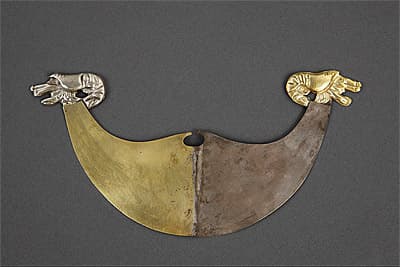
MOCHE culture North coast 100 – 800 AD
Nose ornament 100-800 AD gold and silver5.0 (h) x 15.0 (w) cm Museo Oro del Perú, Lima Photograph: Daniel Giannoni
Moche sea iconography is prominent on the crescent-shaped nose ornament that has each side capped with a gold or silver prawn. Lobster, crabs, prawns and other crustaceans often feature on precious ornaments of this type.
Objects combining gold and silver—like this type of starkly divided nose piece—are often found in Moche graves. For the Moche, gold and silver were significant because they symbolised many dualist aspects of the universe, significantly male–female, sun–moon, right–left and day–night. Many important figures have been found with gold placed on one side of the corpse and silver on the other. When the grave of the Lord of Sipán was discovered, he held a gold nugget in one hand and a silver one in the other. He also wore a half-gold, half-silver beaded necklace. Evidence of this dualism is also apparent in the placement of other items, including tumi blades, coccyx protectors and bells, many of which are clearly divided into silver and gold mirror sections, like these two nose ornaments.1
Gold is generally associated with and located on the right, and silver on the left. The right side was considered masculine, the gender identified with gold, while the left side is feminine and related to silver. These ideas also extend throughout Moche religious beliefs, which are dominated by ideas of sun (masculine) and moon (feminine) and their relationship, again symbolised in the use and juxtapositioning of gold and silver.
Simeran Maxwell
1. Walter Alva and Christopher B. Donnan, Royal Tombs of Sipán, Los Angeles: Fowler Museum of Cultural History, UCLA 1993, pp. 221–23.
Moche sea iconography is prominent on the crescent-shaped nose ornament that has each side capped with a gold or silver prawn. Lobster, crabs, prawns and other crustaceans often feature on precious ornaments of this type.
Objects combining gold and silver—like this type of starkly divided nose piece—are often found in Moche graves. For the Moche, gold and silver were significant because they symbolised many dualist aspects of the universe, significantly male–female, sun–moon, right–left and day–night. Many important figures have been found with gold placed on one side of the corpse and silver on the other. When the grave of the Lord of Sipán was discovered, he held a gold nugget in one hand and a silver one in the other. He also wore a half-gold, half-silver beaded necklace. Evidence of this dualism is also apparent in the placement of other items, including tumi blades, coccyx protectors and bells, many of which are clearly divided into silver and gold mirror sections, like these two nose ornaments.1
Gold is generally associated with and located on the right, and silver on the left. The right side was considered masculine, the gender identified with gold, while the left side is feminine and related to silver. These ideas also extend throughout Moche religious beliefs, which are dominated by ideas of sun (masculine) and moon (feminine) and their relationship, again symbolised in the use and juxtapositioning of gold and silver.
Simeran Maxwell
1. Walter Alva and Christopher B. Donnan, Royal Tombs of Sipán, Los Angeles: Fowler Museum of Cultural History, UCLA 1993, pp. 221–23.
Moche sea iconography is prominent on the crescent-shaped nose ornament that has each side capped with a gold or silver prawn. Lobster, crabs, prawns and other crustaceans often feature on precious ornaments of this type.
Objects combining gold and silver—like this type of starkly divided nose piece—are often found in Moche graves. For the Moche, gold and silver were significant because they symbolised many dualist aspects of the universe, significantly male–female, sun–moon, right–left and day–night. Many important figures have been found with gold placed on one side of the corpse and silver on the other. When the grave of the Lord of Sipán was discovered, he held a gold nugget in one hand and a silver one in the other. He also wore a half-gold, half-silver beaded necklace. Evidence of this dualism is also apparent in the placement of other items, including tumi blades, coccyx protectors and bells, many of which are clearly divided into silver and gold mirror sections, like these two nose ornaments.1
Gold is generally associated with and located on the right, and silver on the left. The right side was considered masculine, the gender identified with gold, while the left side is feminine and related to silver. These ideas also extend throughout Moche religious beliefs, which are dominated by ideas of sun (masculine) and moon (feminine) and their relationship, again symbolised in the use and juxtapositioning of gold and silver.
Simeran Maxwell
1. Walter Alva and Christopher B. Donnan, Royal Tombs of Sipán, Los Angeles: Fowler Museum of Cultural History, UCLA 1993, pp. 221–23.

